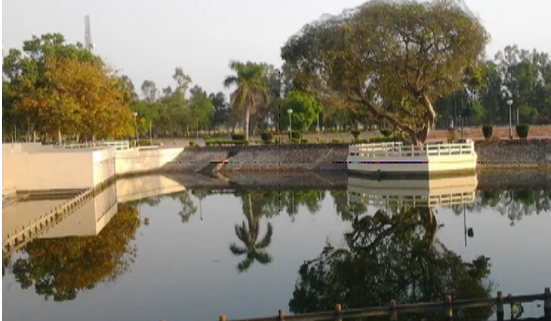Geeta Updesh Sthal Jyotisar, Kurukshetra
The Mahabharat Connection
The Bhagvad Gita was revealed to Arjuna during a discourse by Sri Krishna at Jyotisar. A vat vriksh (banyan tree) provided a fitting backdrop for the sermon’s delivery. According to local lore, this banyan tree in Jyotisar is a descendant of the original sacred Banyan tree beneath which Sri Krishna preached. Lord Shiva was worshipped by Karavas Pandavas in a historic temple in this area.
The Kurukshetra Control Board has renovated and upgraded Jyotisar tirth, a religious historical tourism project. The Haryana Ministry of Culture is collaborating on this project, which includes the development of numerous additional locations throughout Kurukshetra, such as Brahma Sarovar Sannihit Sarovar, Narkatari Baan Ganga, Abhimanyu Ka Tila, and a Mahabharata-themed park.
To begin, there is a museum dedicated to the Bhagwat Gita and the Mahabharat, as well as a number of statues and other trinkets in the area known as the “4 Kos of Kurukshetra Parikrama.” From Pipli to Jyotisar, the rejuvenated Sarasvati river would be widened in Phase 2.
The Braj Kosi Yatra-inspired development of 48 Kos Kurukshetra’s and 134 pilgrimage sites is part of the National Krishna Yatra circuit. Two gigantic temples of Lord Krishna, one in Vrindavan and one in Bangalore, are also being built as part of this national initiative by the Union Government of India and the respective state governments (US105 million).
The Mahabharata light and sound display The Jyotisar lake’s tourism agency organizes a daily light and music laser show depicting scenes from the Hindu epic Mahabharata Bhagwat Gita and Mahabharat Museum. The project includes the creation of a 100,000-square-foot Bhagavad Gita and Mahabharat theme museum at Jyotisar, which will be able to accommodate 10,000 pilgrims each day, thanks to its high-tech digital and virtual reality capabilities.
This Mahabharat and Sri Krishna heritage theme project involves the construction of eight buildings on the bank of the old Jyotisar lake in order to promote international religious tourism. The Mahabharat motif will be applied to each of the four to five-story buildings, giving pilgrims and tourists a sense of immersion in the 18-day-long Mahabharat war. At current exchange rates, the project will cost approximately $30 million.
Jyotisar’s Sound and Light Show
It’s a fascinating Light and Sound Show at Jyotisar, where tourists and locals alike converge to see a period in history and mythology brought to life via a bright medium of colour and light. The essence of the heavenly tales is brought to life via the use of film, light, sound, and water in this multi-sensory event. Visitors and locals alike line up every evening as the sun sets to hear this creative storytelling. This collection of mythical tales is a piece of art in and of itself, thanks to its meticulous research, eye-catching design, and expressive narration. The Bhagwat Geeta and Mahabharata are the center of this open-air performance, which takes place in Jyotisar’s ethereal setting and leaves its audience spellbound.
Facts You Should Know
The Most Excellent Wise One This is where Manu penned Manusmriti.
Additionally, the Rig Veda and Sama Veda were penned at this location.
The Dwapar Yuga came to an end here when Lord Krishna unleashed his terrible power.
Visit During the Summer
The greatest time of year to visit the temple is during the Winter. From September through February, the weather is at its most pleasant.
Weather
April to June are the warmest months, with highs of 42°C during the day and 27°C at night. May is the warmest month, with an average high of 38°C and a low of 23°C. December to February – 18°C during the day and 11°C at night – is the coldest time of year. Dress code for the monsoon season (June to September)
Dhoti or Pyjamas with an over cloth are acceptable attire for males.
For women, sari or half-sari with blouse or chudidhar with pyjama and upper cloth is the most favoured attire.
T-shirts with short sleeves, short-sleeved shirts and low-waist pants are not permitted.



